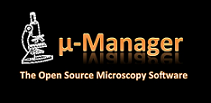Our lab
We perform our experiments in a BioRad PCR machine or a Qiagen Rotor-Gene Q PCR machine we use as temperature controlled fluorimeters.
For spatio-temporal experiments, we work on two Zeiss Axio Observer Z1 fully automated epifluorescence microscope (CoolLed pE-2 or pE-4000 fiber-coupled illuminator, GFP, DAPI, RFP, YFP... filter sets, Marzhauser XY stage and Tokai Hit heating plate) equipped with an Andor iXon Ultra camera or a Hamamatsu C9100 CCD camera, plus sometime a 24x36mm sensor D600 Nikon DSLR for wide field imaging.
Recently, we received an other Zeiss Axio Observer Z1 fully equipped to perform cell culture experiments.
The simplest reactors we use are Vitrocom rectangular glass capillaries. We also uses glass parafilm glass simple chips. In this case a plotter cutter Graphtec is used to cut the parafilm. The multilayer PDMS microfluidic devices that we use sometime are actuated via home-made pneumatic pressure controllers described below and controlled either with MicroManager or Matlab.
It’s a pleasure to make multiposition, multicolor and or multifluidic long term experiments!

Our devices
In the PCR machine, we perform experiments in 20uL tube. Similar experiments can be performed using the epifluorescence microscope and glass parafilm glass simple chip, or NOA81 microfluidic stickers. Typical volume is 5uL. We also work with simple layer and double layer PDMS microfluidic devices, that help us to manipulate fractions of nL volumes. The simplest reactors we use are Vitrocom rectangular glass capillaries. A very good choice for low light imaging. Below a parafilm/glass chip, a PDMS chip and two gradients inside rectangular glass capillaries.

For PDMS molding, we sometimes use PMMA molds that are obtained using micro-milling

MicroManager

μManager is an amazing open source software package for controlling automated microscopes. Almost everything you want to do with your microscope and around is possible. We use it to control and synchronise the microscope (objectives, filters, shutters), the camera, the microfluidic controllers… Everything is explained here: www.micro-manager.org

Microfluidic controllers
In order to control the valves of our PDMS microfluidic devices with a computer, thus precisely control the valve sequence (and synchronise their operation with camera trigger, microscope…), we developped several pneumatic controller using an Arduino electronic card and Lee solenoid valves. Here are the parts that we used to make one of our boxes:

- Manometer LEO 2 (Keller). LEO 2 has 7/16" UNF male thread and G 1/4" male adaptor. (205 € HT). We use the 7/16" UNF connected to a Luer female 1/8" (95962 Fisher) to connect it to tygon tubing 1/8" ID. (11 €/25 U))
- Pressure controller 0-4 bar (0-60PSIG), input max 17.2 bar (250 SPIG), Brooks instrument (8601/D6C11). Joint 1/8" NPT F female.376 € each. We use three polypropylene joint with male thread MNPT on one side and male 1/8" for tygon tube on the other side. (13 €/25 U).
- Tubing. 1/16 ID tygon to connect the electrovalve manifolds to the outputs. 1/8 ID tygon to connect the pressure controller and the manometer
- Output luer Lock-male connectors 1/8" (95919 Fisher)
- Plexiglass machined manifold with 8 holders for Luer Lock-male connectors 1/8".
- High Density Interface (HDI) 3-way Solenoid Valve (non-inert) electrovalves, (The Lee), LHDA 1211111H, 12 VDC, 15 PSID MAX (http://www.theleeco.com).
- Manifold for The Lee electrovalves
- an arduino card (http://www.arduino.cc/) for computer control
- eight NPN Darlington connected transistors (component ULN2803) that serves as relay.
- R1, resistor between the arduino and the LED, 500 Ohm.
- N4148 diode.
- Red LED
- a box

Note: you can see on the pictured box a second pair of pressure controller / manometer, this is independent from valves, we use it to control the pressure of flowing reactants.
Funding
We are or have been funded by the following sources:
-ANR LiLiMat (2023-2027)
-PEPR Molecularxiv (2022-2027)
-CNRS MITI (2020-2021)
-André ERC consolidator grant 'Metabolic soft matter with life-like porperties' (2018-2023)
-City of Paris. Emergence project (2016-2019)
-European commission. FET-STREP young explorers Ribonets project (2013-2016)
-ANR Jeunes Chercheurs DYNANO (2012-2016)
-CNRS INP (2016)
-C'nano Ile-de-France. DIM nanoK (2015)
-Labex Nanosaclay emergence. Project Turnano (2014-2015)
-C'nano Ile-de-France. Postdoc. Enginets project. (2013-2014)
-Triangle de la physique. Project Microgradients. (2010-2012)
